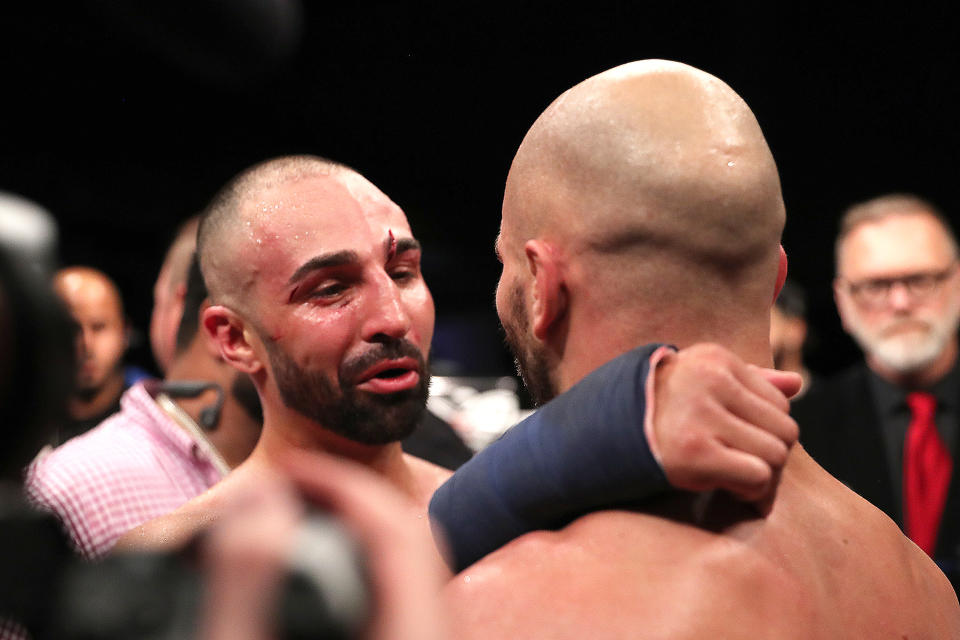Bare knuckle boxing? A pale imitation of the real thing.

There was a reason why, more than 100 years ago, it was decided that professional boxers should wear gloves over their fists.
Because it made the fights better.
Boxing in the first bare knuckle era was an often ugly affair, marred by a lot of mauling, wrestling, throwing one another to the ground, and very few clean punches.
Or, very much like what we now know as MMA.
Saturday night in Tampa, Paulie Malignaggi, a former boxing world champion at 140 pounds, decided to try his hand — or, hands — at this form of throwback boxing against Artem Lobov, a former MMA fighter with a losing record (13-15) who had had one previous fight for something called the Bare Knuckle Fighting Championship.
The result was, predictably, a mess.
ARTEM LOBOV vs. PAULIE MALIGNAGGI Highlights for Bare Knuckle FC 6https://t.co/Ka6eSfS9QI pic.twitter.com/gQyzjs27CE
— The Sports Journal (@TSJSports) June 23, 2019
Both fighters were bloodied. Malignaggi had a vertical split through his left eyebrow that looked as if it had been made by an axe. Lobov had cuts alongside both eyes.
And yet neither fighter had been hit with any truly spectacular punches. There was nothing to compare with the brutal right hand that Deontay Wilder KO’d Dominic Breazale with last month, let alone the lightning-bolt right that won Rocky Marciano the heavyweight title from Jersey Joe Walcott in 1951.
Those fights, of course, were fought with gloves, putting the lie to the belief that somehow, uncovering the fists makes for more brutal action.
Quite the contrary. The boxing glove was designed to protect the man punching, not the man getting punched. The human hand was not designed structurally to collide at high impact with the human skull. In that kind of a crash, the hand always loses. That eight-to-10 ounces of padding over the knuckles is what allows boxers to punch with conviction, again and again, over the course of a 12-round bout.
The glove is what made boxing the beautiful, fluid, strategic — and yes, brutal —sport that it is at its best.
By contrast, bare knuckle fighting is a tentative affair, with both fighters understandably reluctant to let one go at a target that feels comparable to hitting a concrete block. It is nothing but dumbed-down, watered-down boxing, with some horror movie blood smeared on it to give the illusion of savagery.
Malignaggi was by far the better boxer — Lobov fights in a curiously stiff and awkward posture, with his lead hand raised up in the fashion of Norman Bates wielding a butcher knife in the shower — but after he landed his only clean punch of the fight, a right hand to the head in the second round, he stopped throwing much of anything and spent the rest of the fight feinting, circling and flicking light jabs into the air.
Consequently, he lost the decision and afterward, rather predictably, claimed he had broken his right hand. This could not be confirmed minus an X-ray but Malignaggi does have a well-documented history of injuries to his right hand. In 2008, I did the TV commentary for his fight, with gloves, against Lovemore N’Dou in Manchester, England, and sat next to him on the flight back to the U.S. He displayed a busted right hand that was literally folded in half in the shape of a pup tent. So it’s entirely possible that he did something similar trying to dent the rock-like skull of Lobov.
But that was the main problem with this “fight.’’ There was no chance that either fighter would do any real damage.
In spite of all the gore, neither man was “hurt’’ in a boxing sense, meaning neither was shook up or in any danger of being knocked down or out. It was basically two guys in a particularly gory slap fight.
And that is the great lie of bare knuckle fighting, that they are more brutal than a good old-fashioned boxing match. Like many things these days — think “live musical performances’’ that are actually pre-taped and lip-synced — they give the appearance of being something they are not.
A bare-fisted punch will often break a fighter’s skin, but rarely will the damage be more than skin deep. It is simply impossible to hit an opponent as hard and often with a bare fist as one can with a glove. Paradoxically, these combat sports that appear cosmetically more dangerous than boxing are in many ways a heck of a lot safer.
That is why the expression “taking the gloves off’’ to denote a squabble that was about to “get real’’ never made much sense.
You can do a lot more damage with the gloves on.
Saturday night, Malignaggi and Lobov demonstrated that once again. But it’s something boxing people have known for more than 100 years.
More from Yahoo Sports:

 Yahoo Sport
Yahoo Sport 





































